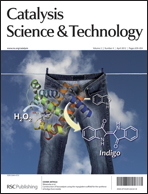Ag nanoparticles decorated polyaniline nanofibers: synthesis, characterization, and applications toward catalytic reduction of 4-nitrophenol and electrochemical detection of H2O2 and glucose†
Abstract
Polyaniline nanofibers (PANINFs) have been facilely prepared by electrochemical


 Please wait while we load your content...
Please wait while we load your content...